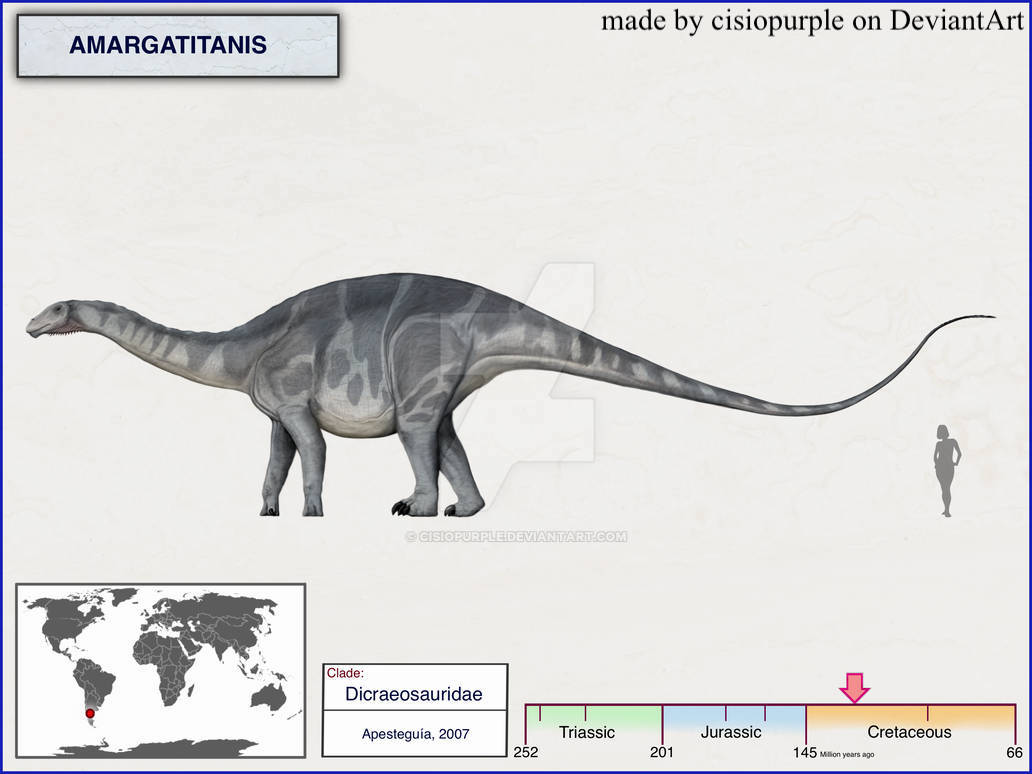Welcome to Amargatitanis

Name Definition
Amarga’s giant (named after the La Amarga Formation where it was discovered)
Name Given By
Sebastián Apesteguía in 2007
Location
La Amarga Formation, Neuquén Province, Argentina
Classification
Dinosauria, Saurischia, Sauropodomorpha, Sauropoda, Diplodocoidea, Dicraeosauridae
Size
a very rough estimate of about 3 meters tall and 11 meters long, though exact size is uncertain due to lack of remains
Temporal Range
Barremian - Aptian stages of the Early Cretaceous, approximately 129.4 - 123 million years ago
Ecological niche
large herbivore
Species/Sub Species
A. macni
Diet
given the diplodocoids’ horizontal position, Amargatitanis would have consumed vegetation on the ground or at a height low enough for it to reach
Introduction
Amargatitanis is a genus of dicraeosaurid sauropods that lived in Argentina during the Early Cretaceous. Amargatitanis means “Amarga titan” which is in reference to being a relatively large dinosaur and also in reference to being discovered in the La Amarga Formation. The specific name macni honors MACN which is the acronym for the Museo Argentina de Ciencias Naturales (The Argentine Museum of Natural Sciences in English) for contribution and devoting human resources to vertebrate paleontology in the 19th and 20th centuries.
The precise size of Amargatitanis would, unfortunately, be hard to ascertain due to the partial nature of the remains, though given most dicraeosaurids were between 10 - 13 meters long, Amargatitanis would have possibly been 11 meters long or more. Most dicraeosaurids are also around 2 - 3 meters tall, so Amargatitanis could have been around 3 or 2 meters tall.
The holotype of Amargatitanis was collected in March, 1983 by Bonaparte, and consists of two caudal vertebrae, a right ischium, and a fragmentary right hindlimb. Although it was originally classified as a titanosaur in its description, the placement of Amargatitanis in the Titanosauria was questioned by later authors who noted that a scapula and six caudal vertebrae interpreted as syntypes of Amargatitanis were found at a different locality than that of the original holotype which would make the titanosaurian characteristics of Amargatitanis invalid. In 2016, a re-evaluation was made by Pablo A. Gallina that recovered Amargatitanis as a dicraeosaurid, meaning it was related to sauropods like Dicraeosaurus and Amargasaurus.
Only known from the La Amarga Formation, Amargatitanis was contemporaneous with the other dicraeosaurid genus Amargasaurus, the stegosaurian genus Amargastegos which is now dubious, the noasaurid theropod Ligabueino, the sauropod Zapalasaurus, the crocodylomorph Amargasuchus, and the cladotherian mammal Vincelestes. Indeterminate remains of a stegosaur and a pterosaur have also been reported from the formation.